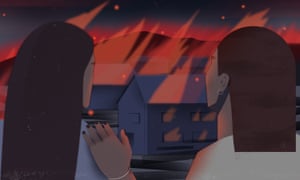
The nightmares kept coming and David Leal knew he was in trouble. A navy veteran with a can-do attitude and a solidly middle-class IT job at a hospital in Santa Rosa, California, he didn’t think of himself as mentally vulnerable. But when the Tubbs fire snatched his house off the face of the earth in the early morning hours of 9 October 2017, it hit him hard.
“Long story short, I went through a lot of PTSD,” Leal says, as we tour his nearly rebuilt home in Santa Rosa’s Coffey Park neighborhood. Wildfires are not uncommon in the mountains outside of this northern California town, but residents can’t remember one like this: the fire jumped six lanes of Highway 101, into the city, and licked up about 1,300 of the suburb’s 2,000 homes as if they’d just evaporated. Leal thought, I live in the city; it’s not supposed to burn.
“Retiring from the navy, I had a lot of junk in my head,” he adds. After the fire, it all came up. “I was having nightmares of occurrences that I went through in the military – but it was going even further back. My brain was just unloading. Every traumatic issue I ever had in my life was coming back to me. There were things that I went through as a little boy that I was waking up going, ‘Whoa. Where did that come from?’”
The climate crisis is manifesting as ever-bigger wildfires, hurricanes, floods and heat waves; and cities are just starting to grapple with the mental impact of the emergency. A climate task force of the American Psychological Association, citing scores of studies over the last decades, reports that survivors of these human-enhanced disasters are experiencing dramatic increases in depression, post-traumatic stress disorder (PTSD), anxiety disorders, suicide and suicidal thoughts, violent behavior and increased use of drugs and alcohol. A Rand study found that one-third of the adult survivors of California wildfires in 2003 suffered depression and one-quarter suffered PTSD.
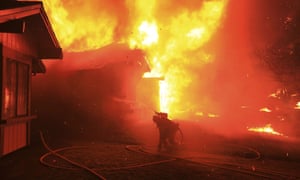
Those with a history of mental or behavioral issues are particularly at risk. But many others are taken by surprise when they suddenly realize they can’t sleep or work, or can’t shake their sadness.
“It’s a normal human response to a terrible thing,” said Adrienne Heinz, a researcher at the US Department of Veterans Affairs (VA) Center for PTSD who lives in Sonoma.
The mental health effects of climate change have been known for quite some time now: a 1991 meta-study found that as many as 40% of those directly impacted by climate-enhanced superstorms and fires suffer acute negative mental health effects, some of which become chronic. Puerto Rico, for example, has seen an epidemic of suicide, PTSD and depression after hurricanes Irma and Maria. After Hurricane Katrina, some people referred to the sense of generalized anxiety and depression common to survivors as “Katrina brain”.
But it’s not just storms that impact mental health. An extensive 2018 Australian study established that extremes of both hot and cold are linked to suicide and mental illness, and the ensuing drought has contributed to a surge in deaths of Australian farmers. Even those not directly impacted by flood or fire can experience a sense of ecological loss termed “eco-anxiety” or “climate grief”.
Lila Iyer, a doctor of internal medicine who works for the VA, was in her home with her husband, Bala, in Santa Rosa’s high-end Fountaingrove neighborhood when 60mph winds pushing ahead of the Tubbs fire began battering their house. She jumped into one car and he into the other. The cars would be among the few possessions the couple managed to save.
The Iyers’ house was reduced to a blackened foundation, the window glass evaporated and metal melted into puddles. Still, within a few days Iyer went back to work. Helping people was her way to cope. Until she herself suddenly needed help.
“After Thanksgiving, the stress hit me, bodily hit me,” she said. “I could feel the anxiety and all that coming.” Iyer saw a psychologist, who recommended she try out what she called a “soul yoga” session for fire victims. The sessions weren’t your typical workout yoga. The sequences of this “trauma-informed yoga” were designed to address the way pain and fear embed in the body, and for Iyer, they made a tremendous difference.
“This is like a PTSD,” Iyer said, “and for myself, the yoga was the best form of treatment.”
The yoga classes Iyer attended were the first initiative of an innovative program called the Wildfire Mental Health Collaborative.
The first-of-its-kind collaborative was established by a not-for-profit in Sonoma county, where Santa Rosa lies, following the fires. It offered residents a set of six tools, including a phone app that allows users to track their affect and behavior, private therapy and trauma-informed yoga – all at no cost.
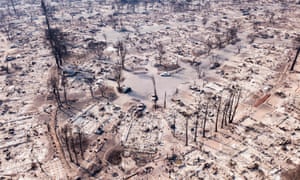
The Healthcare Foundation of northern Sonoma county jumped in to organize the collaborative because residents who’d escaped the fire soon found themselves confronted by another hurdle: government disaster funding may help rebuild their town, but it doesn’t help them cope with the trauma.
In Sonoma, the needs were acute. Outreach workers funded by grants from the Federal Emergency Management Agency (Fema) had made contact with about 70,000 of Sonoma county’s half-million residents following the fires, and referred thousands for mental health services.
But disaster money doesn’t pay for long-term therapy, it’s meant for crisis contact. California’s Department of Health Care Services nor the local government had a pot of money bubbling for that purpose either.
“We knew as people left shelters that they were shellshocked. People were hurting, just really hurting,” said Debbie Mason, the CEO of the Healthcare Foundation of northern Sonoma county.
The collaborative came to life within weeks after the fire, as people who represented mental health professional associations, not-for-profits and clinics in the community asked themselves, “if we were building a fire response for mental health, what would that look like in our community?”, Mason recalled.
The group resolved to use private funding to provide some longer-term help to those identified by the Fema outreach.
The tools they came up with were meant to address residents’ varying needs. Some people just needed to know that their feelings were real and to have someplace to go with them or someone to talk to; others needed long-term psychotherapy.
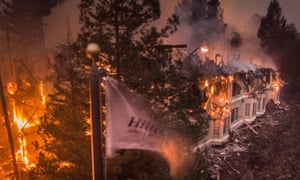
The tools also included Skills for Psychological Recovery training for mental health professionals and first responders. The technique was developed by Heinz’s colleague Joe Ruzek, who formerly worked at the VA, together with the National Child Traumatic Stress Network. Unlike the widely used practice of Psychological First Aid, SPR is not about diagnosing people and getting them into therapy. Rather, it identifies disaster stressors, like not being able to reach the insurance company or missing meds or finding a new school for a child. In times of crisis, these critical tasks can snowball into a personal breakdown.
“SPR is not mental health treatment,” said Christine Naber, a neuropsychologist who co-founded the collaborative. Instead, Naber explained, providers ask clients what they need urgently, what they’re focused on relating to the fire and what they need assistance with – especially when it comes to issues over which clients’ have little control.
SPR was deployed in the aftermath of 9/11; in Newtown, Connecticut, after the school massacre at Sandy Hook; after hurricanes Katrina and Gustav; and after disasters in Canada and Australia. However, most crisis counselors, first responders, and psychological professionals are not currently trained in SPR. Leveraging private funding, the collaborative has now trained over 400 people in SPR, including first responders working on the 2018 Camp fire.
Researchers at Stanford are currently evaluating the impact of the tools offered by the collaborative. Besides the work of the app, they are also studying the usage of SPR by responders and how it affected survivors, as well as the effectiveness of the trauma-informed yoga.
“The biggest goal is being able to share with other communities some information about what works and what doesn’t, and some lessons learned,” said Dr Shannon Wiltsey Stirman, head of the Stanford study. “After a disaster, every community has to scramble and kind of reinvent the wheel.”
Meanwhile, Mason and others in the collaborative have been contacted by communities nationwide looking to share its approach. They’ve also presented the initiative at California’s Office of Emergency Services as a potential disaster response tool statewide. And she’s awaiting another round of presentations to state agencies this fall.
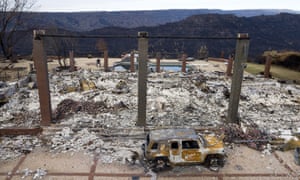
“I’m going to feel victorious if we can get the state to pick this up,” Mason said. “So when the next disaster happens, you go in and say: ‘Here’s the app, here’s the website, here’s the yoga, all that. And here’s the evidence that shows it all works.”
It’s not always easy.
Despite the massive and ongoing destruction caused by wildfires, hurricanes and floods in the US, even a cost-effective program like this is still a hard sell.
Many local governments bank on the belief that there won’t be another hurricane, that no place will burn twice in a lifetime. But that’s not how the world works now. One couple who were in David Leal’s yoga class had lost their home in the Valley fire in Lake county in 2015, then lost their house in Coffey Park in 2017, then moved to the town of Paradise – which was totally destroyed the following year. Last Leal heard, they were living in their pickup camper.
“Right now, when disasters happen in the United States, typically communities are not very well prepared for it,” said Ruzek. “We should be devoting more resources to strengthening and spreading and evolving disaster response and if we did that, that would presumably help communities through all kinds of things.”
To residents like Iyer and Leal, the initiative has been invaluable. “These people are angels,” said Leal of the collaborative. He took some of the free yoga classes and ended up teaching classes himself, crediting this with his own recovery. “They have helped so many people.”
Dean Kuipers writes regularly on the environment, politics and the arts and is the author of the 2019 memoir The Deer Camp, about his family’s relationship to the land.
As the crisis escalates…
… in our natural world, we refuse to turn away from the climate catastrophe and species extinction. For The Guardian, reporting on the environment is a priority. We give reporting on climate, nature and pollution the prominence it deserves, stories which often go unreported by others in the media. At this pivotal time for our species and our planet, we are determined to inform readers about threats, consequences and solutions based on scientific facts, not political prejudice or business interests.
More people are reading and supporting The Guardian’s independent, investigative journalism than ever before. And unlike many news organisations, we have chosen an approach that allows us to keep our journalism accessible to all, regardless of where they live or what they can afford. But we need your ongoing support to keep working as we do.
The Guardian will engage with the most critical issues of our time – from the escalating climate catastrophe to widespread inequality to the influence of big tech on our lives. At a time when factual information is a necessity, we believe that each of us, around the world, deserves access to accurate reporting with integrity at its heart.
Our editorial independence means we set our own agenda and voice our own opinions. Guardian journalism is free from commercial and political bias and not influenced by billionaire owners or shareholders. This means we can give a voice to those less heard, explore where others turn away, and rigorously challenge those in power.
We need your support to keep delivering quality journalism, to maintain our openness and to protect our precious independence. Every reader contribution, big or small, is so valuable.
[“source=theguardian”]


